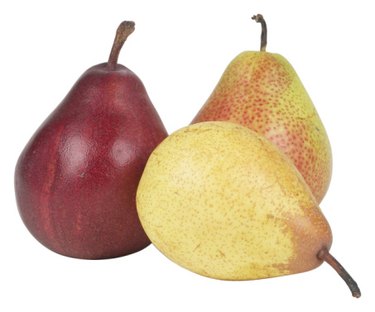
A Chinese farmer harvested 10,000 pears in 2006 that were shaped like baby Buddhas. Inventive farmer, Gao Xianzhang, spent six years perfecting the intricate baby-shaped pears by growing them inside fiberglass molds on the pear trees. He was inspired to create the baby Buddhas by the classic 16th century Chinese novel, "Journey to the West." It tells the story of an imaginary fruit in the shape of a baby that gives eternal life to those who eat it. A connection between the pear tree, Buddhism and immortality have existed in China for 3,000 years.
Long Life
Video of the Day
The ancient Chinese believed that the pear was a symbol of immortality. The long-lived pear tree came to symbolize long life and good fortune. In Chinese literature, especially poetry, the destruction of a pear tree also came to symbolize premature or tragic death. Though there are few representations of pears in Chinese art, where they are found, yellow pears or pear trees are used to symbolize the gold of good fortune and profit.
Video of the Day
Superstition
The word for pear in Chinese, "fen li" literally means "sharing a pear" is pronounced the same way as the word for separation. The symbolism of the pear can be interpreted to mean that sharing a pear can cause separation. Superstitiously, many Chinese do not split a pear with loved ones, lest they be separated.
Botany
China was deeply involved in cultivating pear trees as early as 3,000 years ago. Writings describing pear propagation date to the time between 200 to 1,000 B.C.E. The famous book, "Tsee Ming Yau Su," was penned by Chia Shi-yi in the 6th century. The treatise chronicles pear tree production for the 1,500 years prior to that.
Lore
In Chinese fairy tales and folklore the pear is used metaphorically to illustrate generosity. "King Rong Gave Away Bigger Pears" and "The Magic Pear Tree" both tell of humble people who denied themselves the better or larger pears and chose to give them to others. In the "Magic Pear Tree" story a monk plants a pear seed that instantly grows into a tree. He gives away the fruit.
Commerce
The Chinese export in the early 2000s reached 12.5 million metric tons. The government began in the 1980s to increase pear production. The country became the supplier for more than two-thirds of the pears consumed internationally. Pear trees fill more than 2.5 million acres of China's farmlands.
- Myth Encyclopedia: Fruit in Mythology
- "The New York Times"; From Silk Road to Supermarket, China’s Fragrant Pears; David Karp; November 15, 2006
- Purdue University Horticulture; The Pear in History, Literature, Popular Culture, and Art; Jules Janic
- Daily Mail; Enlightened Chinese Farmer Branches Out by Growing Pears Shaped like Baby Buddha; September 4, 2009
- Chinese E-Learning: Kong Rong Gave Away Bigger Pears